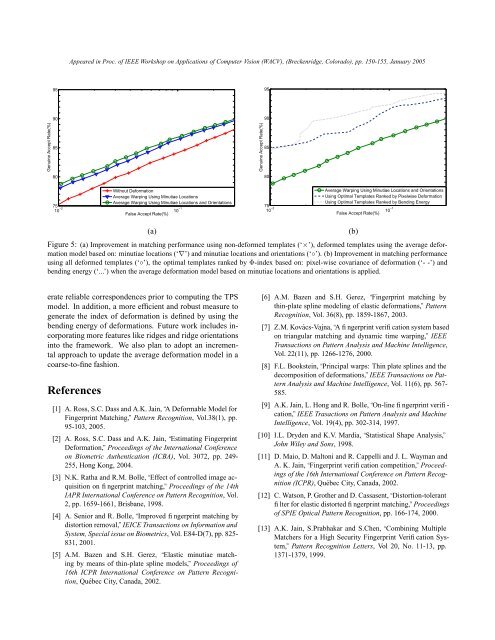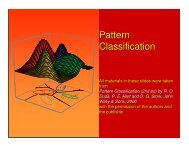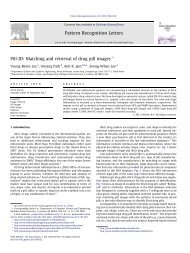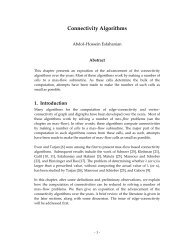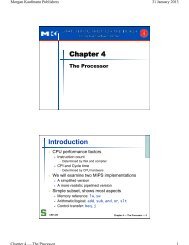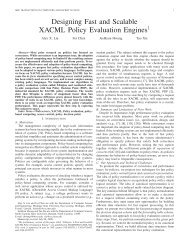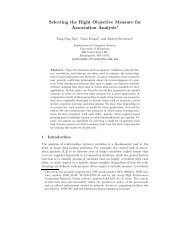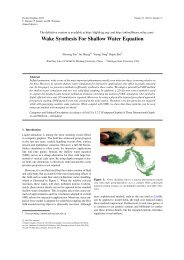Fingerprint Deformation Models Using Minutiae Locations and ...
Fingerprint Deformation Models Using Minutiae Locations and ...
Fingerprint Deformation Models Using Minutiae Locations and ...
Create successful ePaper yourself
Turn your PDF publications into a flip-book with our unique Google optimized e-Paper software.
Appeared in Proc. of IEEE Workshop on Applications of Computer Vision (WACV), (Breckenridge, Colorado), pp. 150-155, January 200595959090Genuine Accept Rate(%)85Genuine Accept Rate(%)858080Without <strong>Deformation</strong>Average Warping <strong>Using</strong> <strong>Minutiae</strong> <strong>Locations</strong>Average Warping <strong>Using</strong> <strong>Minutiae</strong> <strong>Locations</strong> <strong>and</strong> Orientations7510 −2 False Accept Rate(%)10 −1Average Warping <strong>Using</strong> <strong>Minutiae</strong> <strong>Locations</strong> <strong>and</strong> Orientations<strong>Using</strong> Optimal Templates Ranked by Pixelwise <strong>Deformation</strong><strong>Using</strong> Optimal Templates Ranked by Bending Energy7510 −2 False Accept Rate(%)10 −1(a)Figure 5: (a) Improvement in matching performance using non-deformed templates (‘×’), deformed templates using the average deformationmodel based on: minutiae locations (‘∇’) <strong>and</strong> minutiae locations <strong>and</strong> orientations (‘◦’). (b) Improvement in matching performanceusing all deformed templates (‘◦’), the optimal templates ranked by Φ-index based on: pixel-wise covariance of deformation (‘- -’) <strong>and</strong>bending energy (‘...’) when the average deformation model based on minutiae locations <strong>and</strong> orientations is applied.(b)erate reliable correspondences prior to computing the TPSmodel. In addition, a more efficient <strong>and</strong> robust measure togenerate the index of deformation is defined by using thebending energy of deformations. Future work includes incorporatingmore features like ridges <strong>and</strong> ridge orientationsinto the framework. We also plan to adopt an incrementalapproach to update the average deformation model in acoarse-to-fine fashion.References[1] A. Ross, S.C. Dass <strong>and</strong> A.K. Jain, “A Deformable Model for<strong>Fingerprint</strong> Matching,” Pattern Recognition, Vol.38(1), pp.95-103, 2005.[2] A. Ross, S.C. Dass <strong>and</strong> A.K. Jain, “Estimating <strong>Fingerprint</strong><strong>Deformation</strong>,” Proceedings of the International Conferenceon Biometric Authentication (ICBA), Vol. 3072, pp. 249-255, Hong Kong, 2004.[3] N.K. Ratha <strong>and</strong> R.M. Bolle, “Effect of controlled image acquisitionon fingerprint matching,” Proceedings of the 14thIAPR International Conference on Pattern Recognition, Vol.2, pp. 1659-1661, Brisbane, 1998.[4] A. Senior <strong>and</strong> R. Bolle, “Improved fingerprint matching bydistortion removal,” IEICE Transactions on Information <strong>and</strong>System, Special issue on Biometrics, Vol. E84-D(7), pp. 825-831, 2001.[5] A.M. Bazen <strong>and</strong> S.H. Gerez, “Elastic minutiae matchingby means of thin-plate spline models,” Proceedings of16th ICPR International Conference on Pattern Recognition,Québec City, Canada, 2002.[6] A.M. Bazen <strong>and</strong> S.H. Gerez, “<strong>Fingerprint</strong> matching bythin-plate spline modeling of elastic deformations,” PatternRecognition, Vol. 36(8), pp. 1859-1867, 2003.[7] Z.M. Kovács-Vajna, “A fingerprint verification system basedon triangular matching <strong>and</strong> dynamic time warping,” IEEETransactions on Pattern Analysis <strong>and</strong> Machine Intelligence,Vol. 22(11), pp. 1266-1276, 2000.[8] F.L. Bookstein, “Principal warps: Thin plate splines <strong>and</strong> thedecomposition of deformations,” IEEE Transactions on PatternAnalysis <strong>and</strong> Machine Intelligence, Vol. 11(6), pp. 567-585.[9] A.K. Jain, L. Hong <strong>and</strong> R. Bolle, “On-line fingerprint verification,”IEEE Trasactions on Pattern Analysis <strong>and</strong> MachineIntelligence, Vol. 19(4), pp. 302-314, 1997.[10] I.L. Dryden <strong>and</strong> K.V. Mardia, “Statistical Shape Analysis,”John Wiley <strong>and</strong> Sons, 1998.[11] D. Maio, D. Maltoni <strong>and</strong> R. Cappelli <strong>and</strong> J. L. Wayman <strong>and</strong>A. K. Jain, “<strong>Fingerprint</strong> verification competition,” Proceedingsof the 16th International Conference on Pattern Recognition(ICPR), Québec City, Canada, 2002.[12] C. Watson, P. Grother <strong>and</strong> D. Cassasent, “Distortion-tolerantfilter for elastic distorted fingerprint matching,” Proceedingsof SPIE Optical Pattern Recognition, pp. 166-174, 2000.[13] A.K. Jain, S.Prabhakar <strong>and</strong> S.Chen, “Combining MultipleMatchers for a High Security <strong>Fingerprint</strong> Verification System,”Pattern Recognition Letters, Vol 20, No. 11-13, pp.1371-1379, 1999.


